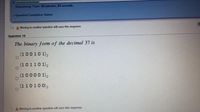
Introductory Circuit Analysis (13th Edition)
13th Edition
ISBN: 9780133923605
Author: Robert L. Boylestad
Publisher: PEARSON
expand_more
expand_more
format_list_bulleted
Question

Transcribed Image Text:Remaining Time: 52 minutes, 52 seconds.
Question Completion Status:
A Moving to another question will save this response.
Quèstion 15
The binary form of the decimal 37 is
(10010 1),
(10 110 1)2
(1 0000 1)2
(1 1010 0),
A Moving to another question will save this response.
Expert Solution
This question has been solved!
Explore an expertly crafted, step-by-step solution for a thorough understanding of key concepts.
Step by stepSolved in 2 steps with 1 images

Knowledge Booster
Learn more about
Need a deep-dive on the concept behind this application? Look no further. Learn more about this topic, electrical-engineering and related others by exploring similar questions and additional content below.Similar questions
- 9)The binary representation of the hex number (2A0B)16= Group of answer choices (10101000001011)2 21011 (0010101000001111)2 No answer text provided.arrow_forwardQ 2arrow_forwardQUESTION 1 You have used DEBUG to unassemble the following instructions. -U 0100 0108 1369:0100 B84365 MOV AX, 6543 1369:0103 BB3394 MOV BX, 9433 1369:0106 F7E3 DEC BX 1369:0108 CD21 INT 21 The last byte of the instruction loaded at address 0106 is stored in address. 0100 0106 0107 0108arrow_forward
- Convert the decimal number 3315.3 to hexadecimal Subtract 14 to 46 using 8 bit 2’s compliment arithmetic In own words explain what is a sequential circuit Construct a Set-Reset (SR) Latch using NOR gates Use perfect induction method to prove De Morgan’s first law involving three variables i.e. (X .Y. Z)’=X’+Y’+Z’arrow_forwardQ2 C only thank youarrow_forwarddesign a two-way traffic light system with prototype using 4-bit down counter circuit. use 7-segment as an output to represent the timer. (the countdown will start at 15)i need help.. pls make a circuit diagram for this. (like circuit wizard or tinkercad) i will do this on the breadboardarrow_forward
- Alert dont submit AI generated answer.arrow_forwardQ26arrow_forwarda) Convert the Decimal number (21.22)10 to binary number b) Convert the binary number (10.011)2 to Decimal number c) Perform the following subtractions using two’s complement arithmetic: X − Y = 1011100 − 1110010 X − Y = 10101111 – 01110011 Please answer all subpart either dislike is ready please Clean handwritingarrow_forward
arrow_back_ios
arrow_forward_ios
Recommended textbooks for you
 Introductory Circuit Analysis (13th Edition)Electrical EngineeringISBN:9780133923605Author:Robert L. BoylestadPublisher:PEARSON
Introductory Circuit Analysis (13th Edition)Electrical EngineeringISBN:9780133923605Author:Robert L. BoylestadPublisher:PEARSON Delmar's Standard Textbook Of ElectricityElectrical EngineeringISBN:9781337900348Author:Stephen L. HermanPublisher:Cengage Learning
Delmar's Standard Textbook Of ElectricityElectrical EngineeringISBN:9781337900348Author:Stephen L. HermanPublisher:Cengage Learning Programmable Logic ControllersElectrical EngineeringISBN:9780073373843Author:Frank D. PetruzellaPublisher:McGraw-Hill Education
Programmable Logic ControllersElectrical EngineeringISBN:9780073373843Author:Frank D. PetruzellaPublisher:McGraw-Hill Education Fundamentals of Electric CircuitsElectrical EngineeringISBN:9780078028229Author:Charles K Alexander, Matthew SadikuPublisher:McGraw-Hill Education
Fundamentals of Electric CircuitsElectrical EngineeringISBN:9780078028229Author:Charles K Alexander, Matthew SadikuPublisher:McGraw-Hill Education Electric Circuits. (11th Edition)Electrical EngineeringISBN:9780134746968Author:James W. Nilsson, Susan RiedelPublisher:PEARSON
Electric Circuits. (11th Edition)Electrical EngineeringISBN:9780134746968Author:James W. Nilsson, Susan RiedelPublisher:PEARSON Engineering ElectromagneticsElectrical EngineeringISBN:9780078028151Author:Hayt, William H. (william Hart), Jr, BUCK, John A.Publisher:Mcgraw-hill Education,
Engineering ElectromagneticsElectrical EngineeringISBN:9780078028151Author:Hayt, William H. (william Hart), Jr, BUCK, John A.Publisher:Mcgraw-hill Education,

Introductory Circuit Analysis (13th Edition)
Electrical Engineering
ISBN:9780133923605
Author:Robert L. Boylestad
Publisher:PEARSON

Delmar's Standard Textbook Of Electricity
Electrical Engineering
ISBN:9781337900348
Author:Stephen L. Herman
Publisher:Cengage Learning

Programmable Logic Controllers
Electrical Engineering
ISBN:9780073373843
Author:Frank D. Petruzella
Publisher:McGraw-Hill Education

Fundamentals of Electric Circuits
Electrical Engineering
ISBN:9780078028229
Author:Charles K Alexander, Matthew Sadiku
Publisher:McGraw-Hill Education

Electric Circuits. (11th Edition)
Electrical Engineering
ISBN:9780134746968
Author:James W. Nilsson, Susan Riedel
Publisher:PEARSON

Engineering Electromagnetics
Electrical Engineering
ISBN:9780078028151
Author:Hayt, William H. (william Hart), Jr, BUCK, John A.
Publisher:Mcgraw-hill Education,